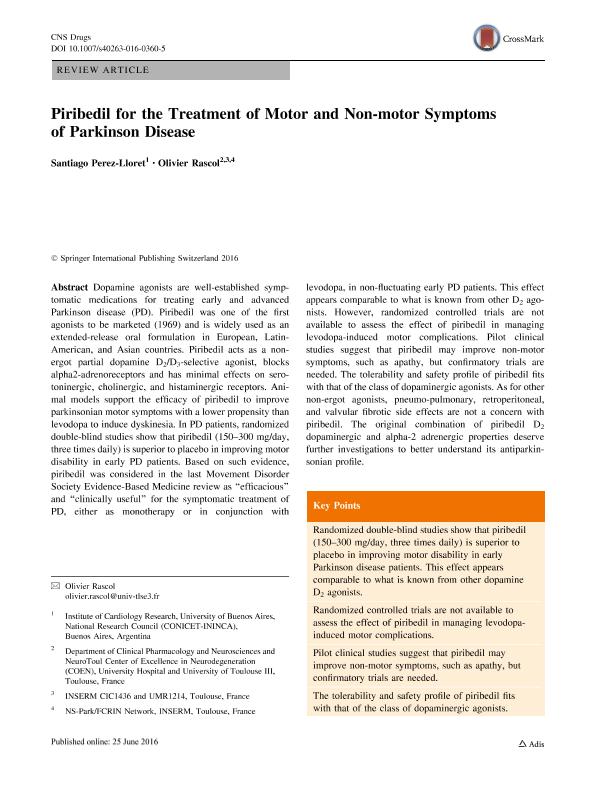Mostrar el registro sencillo del ítem
dc.contributor.author
Pérez Lloret, Santiago

dc.contributor.author
Rascol, Olivier

dc.date.available
2019-10-16T20:37:36Z
dc.date.issued
2016-08
dc.identifier.citation
Pérez Lloret, Santiago; Rascol, Olivier; Piribedil for the Treatment of Motor and Non-motor Symptoms of Parkinson Disease; Adis Int Ltd; Cns Drugs; 30; 8; 8-2016; 703-717
dc.identifier.issn
1172-7047
dc.identifier.uri
http://hdl.handle.net/11336/86094
dc.description.abstract
Dopamine agonists are well-established symptomatic medications for treating early and advanced Parkinson disease (PD). Piribedil was one of the first agonists to be marketed (1969) and is widely used as an extended-release oral formulation in European, Latin-American, and Asian countries. Piribedil acts as a non-ergot partial dopamine D2/D3-selective agonist, blocks alpha2-adrenoreceptors and has minimal effects on serotoninergic, cholinergic, and histaminergic receptors. Animal models support the efficacy of piribedil to improve parkinsonian motor symptoms with a lower propensity than levodopa to induce dyskinesia. In PD patients, randomized double-blind studies show that piribedil (150–300 mg/day, three times daily) is superior to placebo in improving motor disability in early PD patients. Based on such evidence, piribedil was considered in the last Movement Disorder Society Evidence-Based Medicine review as “efficacious” and “clinically useful” for the symptomatic treatment of PD, either as monotherapy or in conjunction with levodopa, in non-fluctuating early PD patients. This effect appears comparable to what is known from other D2 agonists. However, randomized controlled trials are not available to assess the effect of piribedil in managing levodopa-induced motor complications. Pilot clinical studies suggest that piribedil may improve non-motor symptoms, such as apathy, but confirmatory trials are needed. The tolerability and safety profile of piribedil fits with that of the class of dopaminergic agonists. As for other non-ergot agonists, pneumo-pulmonary, retroperitoneal, and valvular fibrotic side effects are not a concern with piribedil. The original combination of piribedil D2 dopaminergic and alpha-2 adrenergic properties deserve further investigations to better understand its antiparkinsonian profile.
dc.format
application/pdf
dc.language.iso
eng
dc.publisher
Adis Int Ltd

dc.rights
info:eu-repo/semantics/openAccess
dc.rights.uri
https://creativecommons.org/licenses/by-nc-sa/2.5/ar/
dc.subject
Parkinson'S Disease
dc.subject
Treatment
dc.subject
Dopamine Agonists
dc.subject
Piribedil
dc.subject.classification
Neurología Clínica

dc.subject.classification
Medicina Clínica

dc.subject.classification
CIENCIAS MÉDICAS Y DE LA SALUD

dc.title
Piribedil for the Treatment of Motor and Non-motor Symptoms of Parkinson Disease
dc.type
info:eu-repo/semantics/article
dc.type
info:ar-repo/semantics/artículo
dc.type
info:eu-repo/semantics/publishedVersion
dc.date.updated
2019-08-30T13:56:54Z
dc.identifier.eissn
1179-1934
dc.journal.volume
30
dc.journal.number
8
dc.journal.pagination
703-717
dc.journal.pais
Estados Unidos

dc.description.fil
Fil: Pérez Lloret, Santiago. Consejo Nacional de Investigaciones Científicas y Técnicas. Oficina de Coordinación Administrativa Houssay. Instituto de Investigaciones Cardiológicas. Universidad de Buenos Aires. Facultad de Medicina. Instituto de Investigaciones Cardiológicas; Argentina
dc.description.fil
Fil: Rascol, Olivier. University of Toulouse III; Francia. Inserm; Francia
dc.journal.title
Cns Drugs

dc.relation.alternativeid
info:eu-repo/semantics/altIdentifier/doi/http://dx.doi.org/10.1007/s40263-016-0360-5
Archivos asociados
